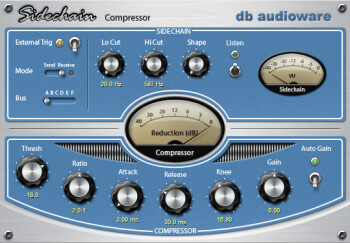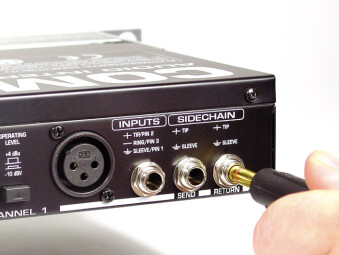Back in the analog area, audio effects with a sidechain circuit were rare and usually among the most expensive. So sidechain was used only in big productions to fine tune the processing of certain recordings. With modern DAWs, sidechains are now available to everyone and most dynamic processors include them. Nowadays, people use the sidechain to create sound effects that are very common in electronic music.
If you take a look at the audio gear market, you’ll notice that those units featuring a sidechain are dynamic processors (compressors, limiters, gates, expanders) and a few exotic effects, like dynamic EQs. In fact, all these processors have something in common: their behavior depends directly on the signal.
Standard dynamic processors use a threshold level to trigger the processing: in a compressor/limiter, the gain is reduced when the input signal level exceeds the threshold; likewise, in a gate/expander, the gain is reduced when the input level drops below the threshold. So the audio source is both the trigger and the object of the processing.
The idea of the sidechain was born from the need to control better the way the processor reacts to the level of the source signal. So, a second circuit was added. The signal in this circuitry is called the “trigger” and it only controls the behavior of the processor. By nature, this signal is not audible in the audio output of the processor. But how can you feed the sidechain and process the trigger signal?
Source signal + filter
The first type of sidechain includes a low-cut filter (or sometimes a low-shelf filter see EQs) and uses the source signal as the trigger signal.
You’ll find this type of sidechain in many compressors because it allows you to reduce the pumping effect when a full-range signal is heavily compressed (see Compressors). Let us explain that better: in an audio signal, most of the energy is concentrated in the low-end. Since the compressor is triggered by the signal level, it is more responsive to low frequencies than to high frequencies. As a consequence, each bass-drum hit triggers the compressor, which results in the attack not being processed while the rest of the signal is damped due to the gain reduction applied. By attenuating the low-frequency range of the trigger signal with the sidechain’s low-cut filter, we decrease the impact of low frequencies in the triggering of the compressor and thus reduce the pumping effect.
In the past, pumping was considered an unwanted effect, but nowadays it is intentionally used in many music genres.
Source signal + insert
The second sidechain type also uses the source signal as the trigger, but replaces the low-cut filter with an insert.
This kind of sidechain can be found in some hardware compressors. The insert (see Insert vs Aux) allows you to process the sidechain signal with an EQ instead of the low-cut filter.
External signal
The last type of sidechain allows you to trigger the processor with any external audio signal. But ─ you’ll say ─ the insert return in the sidechain described above also allows us to feed the detection stage with an external signal! Which is true; this third sidechain type is not really that different.
But why should I use an external trigger signal? The most common application consists in feeding the sidechain of a noise gate with a rhythm signal, in most cases the hi-hat or a percussion instrument, which you can process with an EQ, if necessary. What happens in this case is that the gate closes between the beats in the trigger signal and cuts the source signal regularly. The result is a sort of signal-segmentation effect heard on vocals and lead instruments in many modern productions.
A practical detail
All these features are very nice but how can we control what happens in the sidechain if the trigger signal is not audible? On hardware compressors equipped with a basic sidechain (source signal + low cut), you might have no possibility to monitor the trigger signal, which doesn’t really matter. But generally, sidechain circuits provide features that allow us to switch to an external signal (key input or sidechain input) and to monitor the trigger signal (key listen or sidechain listen).




